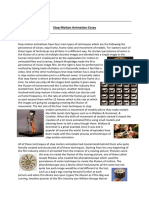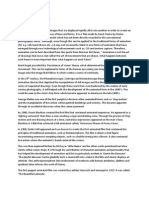Pioneers:
Joseph Plateau
Joseph Plateau was a Belgian physicist who created the Phenakistoscope in
1832. Plateau was mainly inspired by Michael Faraday and Peter Mark Roget.
Faraday created a device which involved two discs spinning opposite each
other called Michael Faradays Wheel. Plateau then adapted Faradays
invention to create a toy called the Phenakistoscope.
The Phenakistoscope has two discs on the same axis. The first disc slots
around the edge whilst the other disc has drawings of something that
involves a fair amount of movement. The drawings were placed all around
the second disc. The discs then spin and when its viewed in a mirror through
the first discs slots, the drawings look as if they are moving.
William Horner
William Horner created the Zoetrope. Horner was inspired by Joseph Plateaus
Phenakistoscope. Horner improved the Phenakistoscope into an item that can
also display still images rather than just drawings.
The Zoetrope is a cylinder with a slit in the side of it; there are a series of
pictures on the inside. When you look through the slits its seems as if the
pictures are moving. This is because the cylinder on the inside rotates fast
enough for humans to merge the drawings together to make it seem as if
theyre moving. Horner then started using still images instead of drawings.
The very first step of modern stop motion.
Developers:
Willis OBrian
Around 100 years after the invention of the Zoetrope, stop-motion animation
had started to been noticed by bigger film companies. Willis OBrian was a
stop motion model animator, he created some of the most well-known stop
motion model animation films such as King Kong. He inspired many other
people to go into stop motion animation and special effects.
Towards the start of his career he created a model of a dinosaur and a
caveman which he then animated with the help of a local news cameraman.
His work was then noticed by Thomas Edison and OBrian was then hired by
Edison to complete multiple prehistoric films such as Prehistoric Poultry. He
used stop motion animation for King Kong in 1933 and for Lost world in 1925.
OBrian was then hired to work on The Ghost Of Slumber Mountain which to
start with wasnt very successful as it was supposed to be a 45 minute film
and had to be shortened down to 11 minutes. Although, the film stilled
grossed a total of $100,000 and this secured OBrian a slot to work on Harry
O. Hoyts The Lost World. During OBrians early career, he used to make his
stop motion models out of clay, but for the Lost World he employed others to
create more detailed models.
�After the success of The Lost World, Willis OBrian began work on creating
models for a film which was initially going to be cancelled due to having a
boring storyline according to Merian C. Cooper. OBrian created models of
Dinosaurs and Gorillas. This film went on to be the well-known King Kong.
This is what really sparked Willis OBrians career.
Ray Harryhausen
Ray Harryhausen was a stop motion animator inspired by Willis OBrian after
seeing King Kong. Harryhausen created a form of stop motion model
animation named the Dynamation. Harryhausen was inspired after watching
King Kong, Willis OBriens stop motion work led him onto creating lots of stop
motion shorts. Harryhausens friend organised a meeting between OBrian
and Harryhausen. OBrian critiqued Harryhausens work and urged him to
take classes so that his models could be perfected.
In 1947, Harryhausen was hired to work on his first major film as an assistant
animator of Willis OBrian. This film turned out to be Mighty Joe Young.
Harryhausen created most of the special effects for this film as OBrian was
left to work on some technical problems. The film won OBrian an award for
the best special effects that year.
Contemporary Work:
Tim Burton
Tim Burton started using stop motion animation at the start of his career. He
created multiple short films using stop motion to animate certain objects. He
created multiple gothic films using stop motion animation such as Corpse
Bride. He used clay sculptures which could be moved to create an animation
effect. The majority of Corpse Bride uses stop motion animation rather than
CGI or computer graphics, although in some parts effects are added
afterwards. Burton was very inspirational to many new film makers and
inspired a lot of people to start using the stop motion animation more often.
Aardman Animations
Aardman Animations used very similar techniques to Tim Burton. They
created clay sculptures which they could move frame by frame to create a
scene. Some famous products created by Aardman Animations are shows
such as Wallace and Gromit and Chicken Run. Aardman Animations aimed
their work towards children and were one of the first companies to do so.
Aardman animations inspired many people to use similar techniques. People
such as Tim Burton and Aardman Animations moulded stop motion into
another format.
Persistence of Vision
A very famous theory states that the human eye always retains images for
around 0.04 of a second. This means that everything we see actually
happened before we see it. It also means that the eye can blend what you
�see. This is why when something is moving really fast it blurs and blends
together because the eye mixes what you saw 0.004 seconds before
together.
Stop-Frame
Stop-frame is the process of taking a photo of an item, then moving it and
taking another photo. If you repeat this for as long as needed it will create an
illusion of movement. The frames together will make it look as if the item is
moving naturally.
Movement of Models
Some companies such as Aardman Animations will use an armature which is
almost like the body or the main frame of the sculpture. Once they have the
main frame of the sculpture they will then add all the details usually using
clay. The frame then can be moved to almost any position making it as lifelike as possible. Once the sculpture is completed they then will start the
process of filming.
Frame Rates
Fps also known as frames per second is how many frames are displayed in 1
second of footage. For steady and smooth footage, 30 frames per second is
enough. If you are looking to slow down your footage and use slow motion,
you can use anywhere from 60+ frames per second. As long as the footage
stays above 30 frames per second. For example, if you used a 60 frame per
second clip, you could slow it down to half the speed and it would be 30
frames per second afterwards. The higher the frame rate is, the slower you
can make your footage.
For stop motion, you can use anywhere from 12 frames per second up. If you
would like the footage to be jumpy and unsteady you can use 12 frames per
second (12 photos per second). But if you are looking for smoother footage,
you should use around 24 frames or more per second. Bigger companies such
as Aardman Animation will use 30 frames per second for stop motion
animation but often will use higher frame rates for certain parts.
Genres and Forms
Stop motion can be used in lots of different genres and forms. There are lots
of different types of stop motion ranging from Wallace and Gromit to Bill and
Ben.
Cinema
An example of a stop motion film is Wallace and Gromit: The Curse Of The
Were Rabbit. The Curse Of The Were Rabbit was released in 2005. It is the
second highest grossing stop motion animation film of all time as of 2016.
The film made $192 million dollars with a budget of $30 million dollars. There
have been lots of stop motion animation films such as Corpse Bride and
�Coraline, both in the top 10 of the highest grossing stop motion animation
films ever.
TV Advertisements
Lots of adverts on television use stop motion animation as its a very cheap
method rather than using special effects and it has a unique style to it.
An example of one of the first adverts to use stop motion is the Lurpak advert
in 1986. The animation was very advanced for its time and also was a lot
cheaper than using computer effects. Since then hundreds of adverts using
stop-motion have been created.
Another example of a stop motion advert is John Lewis advert for home
insurance in 2013. This advert took weeks to complete as they used the
original stop motion method and had to move each piece of furniture piece
by piece.














































































































